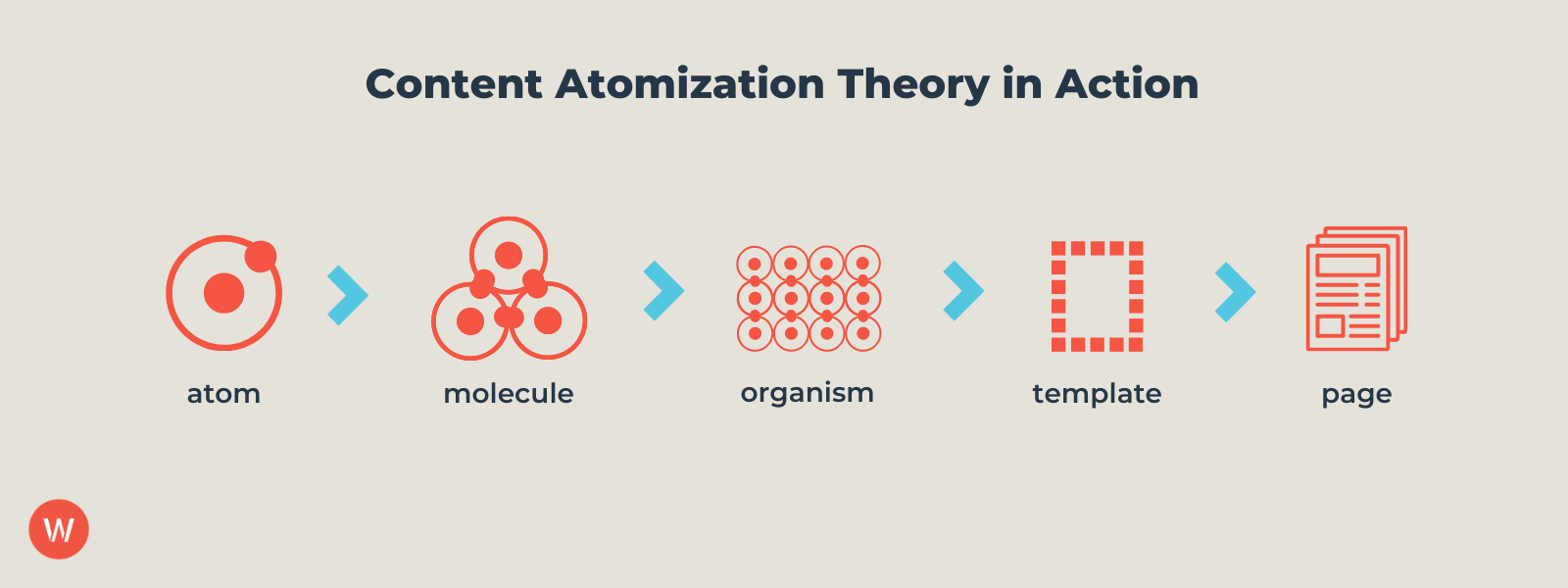It’s 2021, and content is king.
Marketers have said this for years, but now it’s not just wishful thinking. The right content—published and distributed in the most relevant online spaces—can capture your audience’s attention, inspire action, and drive higher engagement across the entire funnel. While all companies rely on innovative content to market their products or services, few (if any) have the resources they need to produce a consistent stream of quality assets that can be thoughtfully adapted to multiple formats, channels, and platforms.
This is known as content atomization.
What is content atomization?
The core concept of atomic content is very similar to atomic design, a mind model that invites designers to look at their pages and products as a complex group of organisms, with each element playing a crucial role in its own right.

In this new paradigm, all “content” is considered to be an amalgamation of “atoms.” By taking your long-form content pieces, or an overarching theme, and breaking it down into smaller, focused, and more strategic content pieces or assets, atomization builds more value into your sales and marketing materials over time.
It also enhances your overall marketing strategy by keeping your brand relevant in the eyes of fragmented audiences: customers who consume media in all different forms and across all different channels.
If we’ve lost you with all the details, just remember that content atomization will help you:
- Serialize content so you’re delivering smaller, but more substantive, pieces of content to your audience (over a series of days, weeks, etc.)
- Dynamically, and often in real time, combine different content “atoms” to create a more relevant overall experience that meets the specific needs of your customers based on where they are in their journey
- Squeeze the most out of every existing piece of content and content idea that you’ve developed so that you’re using your resources as efficiently as possible—and so your content ultimately delivers better results
Is atomic content the same as content repurposing?
If you’ve ever written an ebook or a white paper, you’ve probably split it up into a blog series or several micro-visuals to share on social. This is referred to as “content repurposing” or “content recycling.” It’s a very effective way to get more bang for your buck, and a fabulous content marketing technique that we often employ for our clients.
Because content repurposing breaks larger pieces of content into smaller, more digestible pieces, people often associate it with the term “atomic content.” But that would be an oversimplification.
Repurposing content means to simply reshare it or copy pieces of it from one format into another (i.e. a white paper broken up and reshared as a series of blog or social posts). Content atomization, on the other hand, involves the creation of new assets based on the larger piece of content. Each new piece of content you create should feel like a fresh asset rather than stale repetition.
Atomic content works smarter, not harder
Content atomization amplifies your message throughout a variety of forums, making it easier for your intended customer to recognize your name and associate it with your expertise on a particular topic.
When done right, content atomization also has the potential to unlock:
- Scalability: Atomic content allows you to scale and do more with less. Instead of manually creating a thousand pages of similar information, atomic content allows you to inject relevant information to each individual page. This is how atomic content and content repurposing go hand in hand. When you build your content infrastructure with little atoms that flow into molecules, organisms, and eventually full-on pages, you can repurpose each of those content nuggets into several places throughout the funnel.
- Personalization: Let’s say you work at a travel company or hotel that has multiple locations, each offering its own unique deals, rates, and options. Based on how a user interacts with your home page, you can leverage atomic content to customize their journey with specific recommendations (i.e. if they’re exploring Aspen ski lodges, you can recommend a ski lesson add-on, which would be way more relevant to them than a surfing package). With the impending doom of third-party cookies fast approaching, on-site personalization is key to driving more meaningful, highly tailored customer experiences. As targeting options grow slimmer, it’s up to marketers to use what they know about user behavior on their sites to provide the most relevant experience possible.
- Quality Control: Brands that mention discount or deal verbiage throughout the customer experience, on product pages, blogs, etc., tend to see higher conversions. But updating all 500+ blogs that mention the product that is currently on sale for the week would be a logistical nightmare. Atomic content to the rescue! By dynamically inserting discount verbiage as a content “atom,” you are saving yourself the time spent on updating your blogs and ensuring that all of your information is accurate and up to date.
- Regulated Content: Content creation can be quite the headache in highly regulated industries like alcohol, real estate, and finance (IYKYK). One piece of content might be stuck in legal review for months before getting kicked back due to some nuanced change about how you’re allowed to speak about a certain topic. With atomic content, regulated information like your credit card’s APR, for example, can be injected into content dynamically. That way, when legal approves it once, there’s one owner for the rate and all of the content pieces on your site that reference it can be updated with the click of a button.
- Testing, Testing, Testing: If you’re doing A/B tests on your site, you’re likely already tapping into the concept of atomic content—just on a smaller scale. When you develop your company’s web pages atomically, you can easily identify and test atoms, or groups of atoms. Does the promo-focused blog outro atom perform better than an email sign-up blog outro? When your results come back, you can easily update all of your blogs to utilize the winning atom.
Tackling atomic content challenges
There are some challenges associated with shifting to a content atomization model. Namely, atomic content requires:
- A paradigm shift: Typically, by the time you’re in a tough spot and wish you could use atomic content, it may already be too late. Like all good things, reaping the benefits of atomic content means you have to sow the seed early and diligently.
- A centralized content operation: If person A on your team is extremely diligent about using atomic content to insert content nuggets into your company’s web pages, but person B doesn’t follow the agreed-upon content processes, then the ecosystem is fragmented and your team will struggle to scale.
- A lengthy set-up time: Although atomic content allows you to scale and speed up content production, the setup of an atomic content process in your organization can take a long time. Oftentimes, a shift like this also requires hours of education to reskill existing content operations personnel.
So what do you need to do to ensure success?
Putting your atomic content strategy into action
Delivering a tailored, personalized experience requires integrating new technology, customer needs, and content into a cohesive, atomic content strategy. Here’s how you can get started:
- Dig into your data
- Atomic content experiences are built with data. Assess available data for insights that can help you determine what factors are most effective in driving dynamic experiences. Consider data that indicates customer status, persona type, transaction history, or potential customer lifetime value (LTV). And make sure your data sources can easily integrate with the marketing technologies you use to deliver atomic content experiences.
- Prioritize personas
- Building on your existing data and insights, prioritize core buyer personas based on customer value, strategic priority, or other criteria that align with current organizational objectives. The purpose is to identify and focus on a handful of key personas.
- Understand where content customization could be most relevant for each persona, as not all buyer personas are of equal business value. Prioritize initial atomic content efforts to focus on the most significant audiences.
- Leverage your existing martech stack
- Embrace out-of-the-box tools and technologies to make a meaningful impact without introducing new complexity. Marketing automation, email marketing, and content management solutions often have standard features that support atomic content capabilities. Audit current vendors to understand the extent of their existing dynamic content functions, and then make the most of those features.
- Remember that atomic content requires marketing leaders to explore new ways of creating and delivering content. Your ultimate aim should be to create a customized, highly relevant customer experience.







Responses